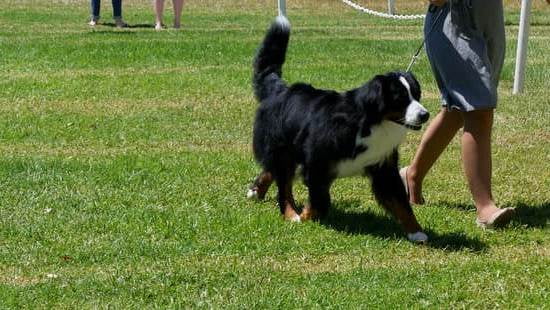As our canine companions age, they may experience physical and mental changes that can make leash training more challenging. In this article, we will explore the unique challenges of training an older dog to walk on a leash and provide helpful tips and strategies for overcoming these obstacles. If you’re wondering how to train an older dog to walk on a leash, you’ve come to the right place.
First, we will delve into the specific challenges that come with walking an older dog, including potential health issues and behavioral changes. Then, we will discuss how to identify the root cause of any leash training issues your older dog may be experiencing. Additionally, we’ll provide insights into selecting the right leash and collar for an older dog, as well as introducing positive reinforcement training methods to facilitate successful leash training.
Leash training an older dog requires patience, understanding, and a tailored approach that takes into account their individual needs and limitations. By addressing common behaviors such as fear, anxiety, pulling, and lunging, you can work towards creating a consistent walking routine and setting realistic goals for your senior pup. With persistence and dedication, you can successfully train your older dog to walk on a leash in a way that is both safe and enjoyable for them.
Identifying the Root Cause of Leash Training Issues
As pet owners, it is important to recognize that older dogs may face unique challenges when it comes to leash training. Identifying the root cause of leash training issues in older dogs is crucial in developing an effective training plan. Whether your older dog is showing signs of fear, anxiety, or has developed a pulling or lunging behavior, understanding the underlying reasons behind these issues is the first step towards successful leash training.
Physical Limitations
Older dogs may experience physical limitations such as arthritis or joint pain, which can make walking on a leash uncomfortable for them. It’s important to observe your dog’s movements and consult with a veterinarian to determine if any physical condition is contributing to their reluctance to walk on a leash. Adjusting the walking routine and selecting the right leash and collar can be beneficial for older dogs with physical limitations.
Past Trauma or Negative Experiences
Some older dogs may have had negative experiences in the past that are now affecting their behavior during leash training. It’s essential to take into account your dog’s past experiences and work towards building trust and confidence through positive reinforcement methods. Creating a safe and comfortable environment for your older dog during training sessions is key in overcoming any past trauma related to leashes and collars.
Cognitive Decline
For some senior dogs, cognitive decline can impact their ability to learn new behaviors, including walking on a leash. If you suspect that cognitive decline is contributing to your dog’s leash training issues, patience becomes even more important. Training sessions should be kept short and simple, with frequent breaks to avoid overwhelming your older dog. Seeking guidance from a professional trainer experienced in working with senior dogs can also be beneficial in these cases.
By identifying the root cause of your older dog’s leash training issues, you can tailor your approach to address their specific needs and set realistic goals for their training journey. Remember that patience, understanding, and consistency are crucial when working with older dogs on leash training.
Selecting the Right Leash and Collar for an Older Dog
As your older dog ages, you may notice changes in their behavior and physical abilities, including their walking patterns and habits. When it comes to leash training an older dog, it’s important to select the right leash and collar to ensure their comfort and safety during walks. Older dogs may have specific needs when it comes to walking equipment, so it’s essential to consider these factors when choosing the right gear.
When selecting a leash for an older dog, consider their size, strength, and any existing health conditions they may have. For smaller or senior dogs with mobility issues, a lighter and shorter leash may be more suitable to prevent them from tripping or getting tangled during walks. On the other hand, larger breeds may require a stronger and longer leash that gives them more freedom of movement while still allowing you to maintain control.
In addition to the leash, choosing the right collar for your older dog is crucial for their comfort and safety during walks. Older dogs with sensitive necks or trachea issues may benefit from using a harness instead of a traditional collar.
Harnesses distribute pressure more evenly across the chest and back, reducing strain on the neck and throat. For dogs that tend to pull or lunge while on a walk, a no-pull harness can provide better control without causing discomfort.
It’s important to keep in mind that every older dog has unique needs when it comes to walking equipment. Take the time to assess your dog’s specific requirements before making your selection, ensuring that they are comfortable and secure during their walks.
| Leash Selection Considerations | Collar/Harness Considerations |
|---|---|
| Size of the dog | Sensitive neck or trachea issues |
| Strength of the dog | Breeds prone to pulling or lunging |
| Potential health conditions | Comfort and safety concerns |
Introduction to Positive Reinforcement Training Methods
As older dogs may have established habits and behaviors, it is important to approach leash training with positive reinforcement methods that focus on rewarding desired behaviors rather than punishing unwanted ones. Positive reinforcement is a gentle yet effective way to encourage older dogs to learn new skills, such as walking on a leash. By using rewards such as treats, praise, and favorite toys, you can motivate your older dog to follow your lead during walks.
Understanding the Principles of Positive Reinforcement
Positive reinforcement training relies on the principle of rewarding good behavior to increase the likelihood of it being repeated. When your older dog walks calmly on the leash without pulling or lunging, be sure to offer plenty of verbal praise and a tasty treat as a reward. This method helps to build a positive association with walking on a leash and encourages your dog to continue behaving well.
Implementing Positive Reinforcement Techniques During Leash Training
During leash training sessions, be consistent in using positive reinforcement techniques whenever your older dog exhibits the desired behavior. For example, if your dog stays by your side instead of pulling ahead, immediately reward this behavior with a treat and enthusiastic praise. Be patient and consistent in providing rewards for good behavior, as this will help reinforce positive walking habits in your older dog.
Focusing on Patience and Consistency
When employing positive reinforcement methods in leash training for an older dog, it is crucial to remain patient and consistent. Older dogs may take longer to learn new behaviors compared to younger ones due to decreased mobility or potential health issues. It’s essential to provide clear communication, gentle guidance, and unwavering support throughout the training process. Consistent use of positive reinforcement will help your older dog feel confident and motivated during leash training sessions.
Creating a Consistent Walking Routine for Older Dogs
As older dogs age, their energy levels and physical abilities may change, making it important to establish a consistent walking routine that takes their needs into consideration. Here are some tips on how to train older dog to walk on leash:
1. Schedule regular walks: Older dogs may not be able to take long walks like they used to, but scheduling shorter, more frequent walks can help them stay active and maintain a healthy weight. Aim for at least two 15-20 minute walks per day, adjusting the duration based on your dog’s individual needs and physical condition.
2. Use a comfortable leash and collar: When training an older dog to walk on a leash, it’s important to choose the right equipment that is both comfortable and secure. Consider using a harness instead of a traditional collar, as it can distribute pressure more evenly across the body and reduce strain on the neck.
3. Establish a routine: Dogs thrive on routine, so try to walk your older dog at the same time each day. This can help them feel more secure and confident during their walks, as they will know what to expect.
4. Incorporate mental stimulation: In addition to physical exercise, older dogs also benefit from mental stimulation during their walks. Try incorporating training exercises or puzzle games into your walking routine to keep your dog’s mind sharp and engaged.
5. Be patient and supportive: Older dogs may take longer to adjust to new routines, so it’s important to be patient and supportive during the leash training process. Offer plenty of praise and encouragement when your dog follows commands or displays good behavior during walks.
By creating a consistent walking routine tailored to the specific needs of an older dog, pet owners can ensure that their furry companions remain active and healthy well into their golden years.
Overcoming Fear and Anxiety in Older Dogs During Leash Training
When it comes to leash training an older dog, it’s important to recognize that fear and anxiety can often be a major hurdle. Older dogs may have had negative experiences with leashes in the past, or they may simply be more set in their ways and resistant to change. Here are some tips for overcoming fear and anxiety in older dogs during leash training:
- Gradual Exposure: One of the best ways to help an older dog overcome fear and anxiety during leash training is through gradual exposure to the leash and harness. Start by allowing your dog to sniff and investigate the leash without any pressure to wear it or go for a walk. Over time, gradually introduce the leash by letting your dog wear it around the house or yard before attempting to take them for a walk.
- Positive Associations: Associate the leash and harness with positive experiences by offering treats, praise, and rewards whenever your older dog shows calm and relaxed behavior while wearing the gear. This will help them learn to associate the leash with positive experiences rather than fear and anxiety.
- Patience: Older dogs may take longer to adjust to new routines, so it’s important to be patient throughout the process. Don’t rush your dog or force them into situations that make them anxious – instead, take small steps and celebrate any progress along the way.
By understanding your older dog’s individual needs and using positive reinforcement techniques, you can help them overcome fear and anxiety related to leash training. Remember that each dog is unique, so what works for one may not work for another. If you find that your efforts are not making progress, don’t hesitate to seek professional help from a trainer experienced in working with older dogs on leash training issues.
Addressing Common Leash Pulling and Lunging Behaviors
Older dogs can sometimes develop leash pulling and lunging behaviors during walks, which can be challenging for both the dog and the owner. It’s important to address these behaviors to ensure a safe and enjoyable walking experience for both you and your furry companion. Understanding the root cause of these behaviors is crucial in addressing them effectively.
One common reason for leash pulling and lunging in older dogs is discomfort or pain while walking. Arthritis or other age-related health issues can make it difficult for older dogs to walk comfortably, leading to frustration and anxiety during walks. It’s essential to have your veterinarian assess your dog’s physical condition and provide any necessary treatment or medication to ease their discomfort.
In addition to physical discomfort, fear and anxiety can also contribute to leash pulling and lunging behaviors in older dogs. Changes in surroundings, unfamiliar noises, or encounters with other animals may trigger anxiety in older dogs, causing them to exhibit reactive behaviors such as pulling on the leash. Using positive reinforcement training methods can help build confidence in older dogs and reduce their anxiety during walks.
Patience and Persistence
Walking an older dog on a leash can present its own set of challenges, but with patience and persistence, it is possible to successfully train them to walk on a leash. Older dogs may have developed certain habits or behaviors that make leash training more difficult, so it’s important to approach the training process with understanding and compassion.
One of the key tips for successfully training an older dog to walk on a leash is to be patient with them. Older dogs may not pick up on leash training as quickly as younger dogs, so it’s important to give them time to adjust and learn at their own pace. Rushing the training process can lead to stress and anxiety for your dog, which can make the training even more challenging.
In addition to patience, persistence is also crucial when it comes to leash training an older dog. Consistency is key in reinforcing positive behaviors, so it’s important to dedicate time and effort into practicing walking on a leash with your older dog regularly.
By consistently working with your dog and providing positive reinforcement, you can help them develop good leash walking habits over time. Remember that every dog is different, and some may take longer than others to grasp leash training, but being persistent will ultimately pay off in the end.
It’s also important to keep in mind that every older dog has their own unique personality and quirks, so what works for one dog may not work for another. Understanding your dog’s individual needs and adjusting your training approach accordingly is essential in successfully training them to walk on a leash.
By taking the time to understand your older dog’s specific challenges and working patiently and persistently with them, you can help them become comfortable and confident walking on a leash.
Celebrating Progress
When it comes to training an older dog to walk on a leash, celebrating progress and setting realistic goals is key to success. Older dogs may have physical limitations or behavioral issues that make leash training more challenging, so it’s important to approach the process with patience and understanding.
One of the first steps in celebrating progress is to identify small achievements and milestones during the leash training process. This could be as simple as walking a few steps without pulling on the leash or displaying calm behavior when encountering other dogs or distractions. By recognizing these small victories, you can build confidence in both yourself and your older dog, making the overall training experience more positive.
Setting realistic goals for leash training an older dog is crucial for success. Understand that it may take longer for an older dog to adjust to leash training compared to a younger, more energetic dog. Set achievable goals such as walking a certain distance without pulling, gradually increasing the duration of walks, or mastering basic commands while on leash. By breaking down the training process into smaller, manageable goals, you can track your progress and celebrate each step forward.
In addition, consider that every older dog is unique and may have different needs and abilities when it comes to leash training. Be flexible in adjusting your goals based on your dog’s individual progress. What works for one older dog may not work for another, so tailor your expectations and objectives accordingly. Remember that the ultimate goal is to create a positive and enjoyable walking experience for both you and your furry companion.
Seeking Professional Help
In conclusion, training an older dog to walk on a leash can be a challenging but rewarding experience. Understanding the challenges that come with walking an older dog, such as physical limitations and behavioral issues, is crucial in developing an effective leash training plan. Identifying the root cause of your older dog’s leash training issues will help you tailor your approach to address their specific needs.
Selecting the right leash and collar for an older dog is important for their comfort and safety during training. Positive reinforcement training methods have been proven to be effective for dogs of all ages, including older dogs. Consistency is key when creating a walking routine for older dogs, as it helps them feel more secure and confident during walks.
It’s normal for older dogs to experience fear and anxiety during leash training, but with patience and persistence, these issues can be overcome. Addressing common leash pulling and lunging behaviors requires understanding the triggers and using positive reinforcement to encourage more desirable behaviors. Celebrating progress along the way while setting realistic goals will keep you motivated and help track your dog’s improvement.
If you find yourself struggling to make progress despite your best efforts, it may be time to consider seeking professional help from a trainer experienced in working with older dogs on leash training techniques. Remember, every dog is different, so don’t hesitate to reach out for help if needed when taking on the challenge of training an older dog to walk on a leash.
Frequently Asked Questions
Can Older Dogs Be Leash Trained?
Older dogs can definitely be leash trained, although it may require more patience and consistency compared to training a younger dog. It’s important to start with basic commands and gradually introduce the leash to help the dog get used to it.
Is It Too Late to Train My Dog to Walk on a Leash?
It’s never too late to train a dog to walk on a leash, regardless of their age. While it may take more time and effort with an older dog, consistent training and positive reinforcement can still be effective in teaching them leash manners.
How Do I Get My Stubborn Dog to Walk on a Leash?
When dealing with a stubborn dog, it’s essential to be patient and use positive reinforcement techniques such as treats or praise to encourage them to walk on a leash. Consistency, patience, and persistence are key when working with a stubborn dog.

Welcome to the blog! I am a professional dog trainer and have been working with dogs for many years. In this blog, I will be discussing various topics related to dog training, including tips, tricks, and advice. I hope you find this information helpful and informative. Thanks for reading!





